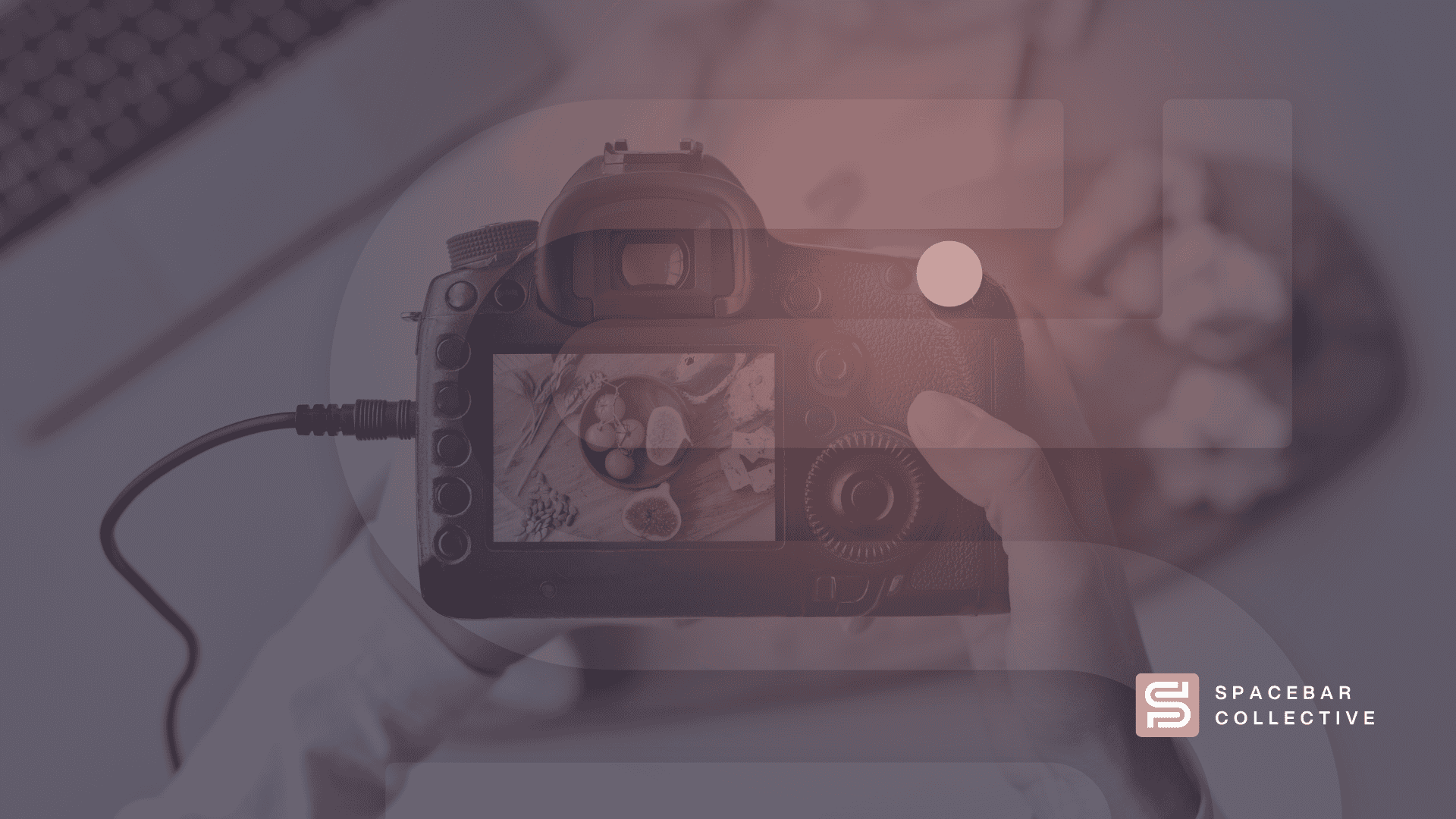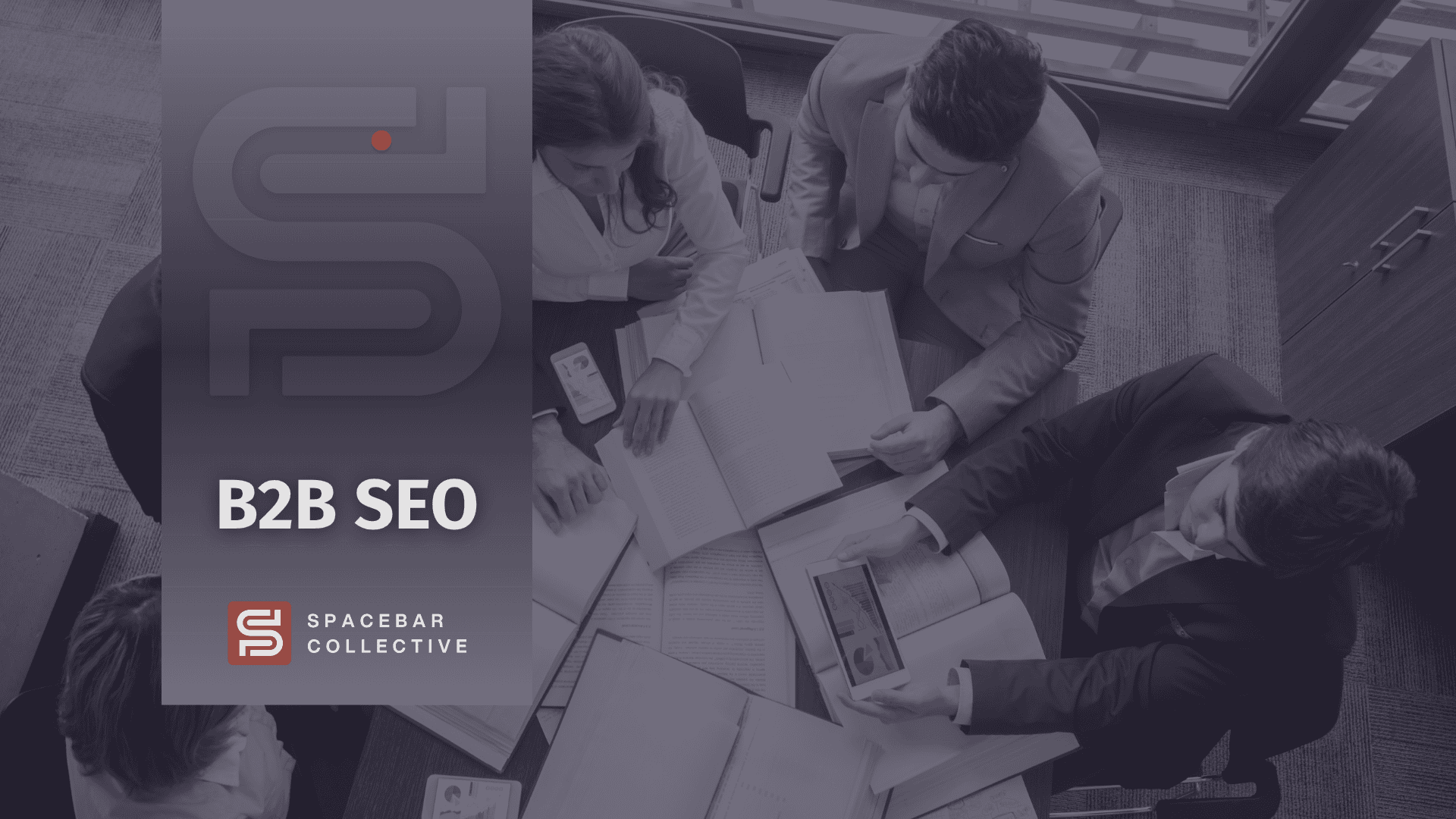B2B SaaS Content Marketing Explained
B2B SaaS content marketing is any strategic approach used by businesses to attract and engage potential users for a software-as-a-service (SaaS) product. What makes B2B SaaS content stand out from other industries is that it focuses on creating and distributing valuable, relevant and consistent content to attract and retain a highly targeted audience that falls under an Ideal Customer Profile (ICP).
The primary goal of B2B SaaS content marketing is to drive profitable customer action by being a source of practical information and building brand awareness. This is achieved through various channels like social media, webinars, case studies, whitepapers and blogs.
By delivering a consistent stream of high-quality content to potential users, B2B SaaS companies are aiming to establish themselves not only as thought leaders within their industry, but also convert leads into paying users.
What’s different about B2B SaaS marketing?
B2B SaaS products are more complex typically and have longer sales cycles than B2C products. The longer the sales cycle, the higher levels of trust need to be built up for customers to make purchase decisions. This means the approach to marketing needs to be focused on educating, nurturing and establishing a connection with potential customers.
On top of this, B2B SaaS content marketing has to sell not only the software, but also the support behind the software as well. Users need to be confident in the software’s capabilities to improve their business and the support systems needed to guide them through implementation.
Benefits of SaaS Content Marketing
Content marketing has massive advantages for SaaS companies at every stage of the buyer journey. Here are some key benefits you should keep in mind:
Customer Education: Content marketing should educate customers at every stage of the buyer journey. Marketing specific to SaaS focuses on creating valuable and informative content that drives readers through the sales funnel. This is done through in-depth explanations, tutorials and blogs that showcase specific features of the software. The bottom line here is that SaaS content marketing should provide practical insights and real-life examples that are relevant to the reader.
Building Trust: Content is a powerful tool for building trust among potential customers, allowing SaaS companies to demonstrate their industry expertise and knowledge to establish credibility. By directly addressing pain points and needs, SaaS content instils trustworthiness in the brand.
Cheaper Customer Acquisition: SaaS content marketing can lower customer acquisition cost (CAC) in several ways: improving brand visibility, attracting qualified leads and new signups through organic growth channels.
Community Building: The right types of content will build and nurture a community of users by being a point of discussion. By consistently providing valuable content, SaaS companies can become a go-to resource for industry and niche-specific information. This not only helps attract potential users but also establishes credibility with existing users.
Lead Nurturing: Content marketing is a powerful tool for nurturing leads, as it allows you to engage with potential customers at every stage of the buying process. The first step in nurturing leads is to create brand awareness, educating your target audience about the benefits of your software. Once you’ve captured their attention, keeping them engaged with practical information like use cases or success stories will position you as viable solution for them.
Reduces Churn: Content helps establish strong relationships between a SaaS and its users. When users feel connected to a brand and receive ongoing support from them, they’re much more likely to continue using the service. You can reduce churn by understanding the needs and pain points of different user segments then creating content tailored towards them.
Customer Communication: Being in constant contact with your users is a surefire way to build long-lasting relationships. Communicating your new product and feature updates is an easy way to stay top of mind with your existing user base.
Marketing Funnel Stages
The standard marketing funnel, sometimes called the sales funnel, consists of 6 stages, each with its own nuances and types of content that performs better. It acts as a visual representation of the customer journey from brand awareness to making a purchase.
- Awareness: In the first stage of the funnel, businesses aim to create brand awareness within their target audience through various channels like advertising, social media and SEO.
- Interest: Once a potential customer is aware of your brand, they are in the interest stage. It’s here that they show interest in your products or services and begin researching more about them.
- Consideration: Potential customers have shown a level of interest in your brand and are considering making a purchase. It’s here where they begin to compare your brand to competitors’ offerings.
- Intent: The potential customer has made up their mind about choosing your product or service but still needs an extra push to convert into a paying customer (or free signup in the case of freemium SaaS).
- Evaluation: During this stage of the funnel, potential customers are carefully evaluating their options before making a final decision.
- Purchase: The final stage of the marketing funnel, where a potential customer becomes a paying customer.
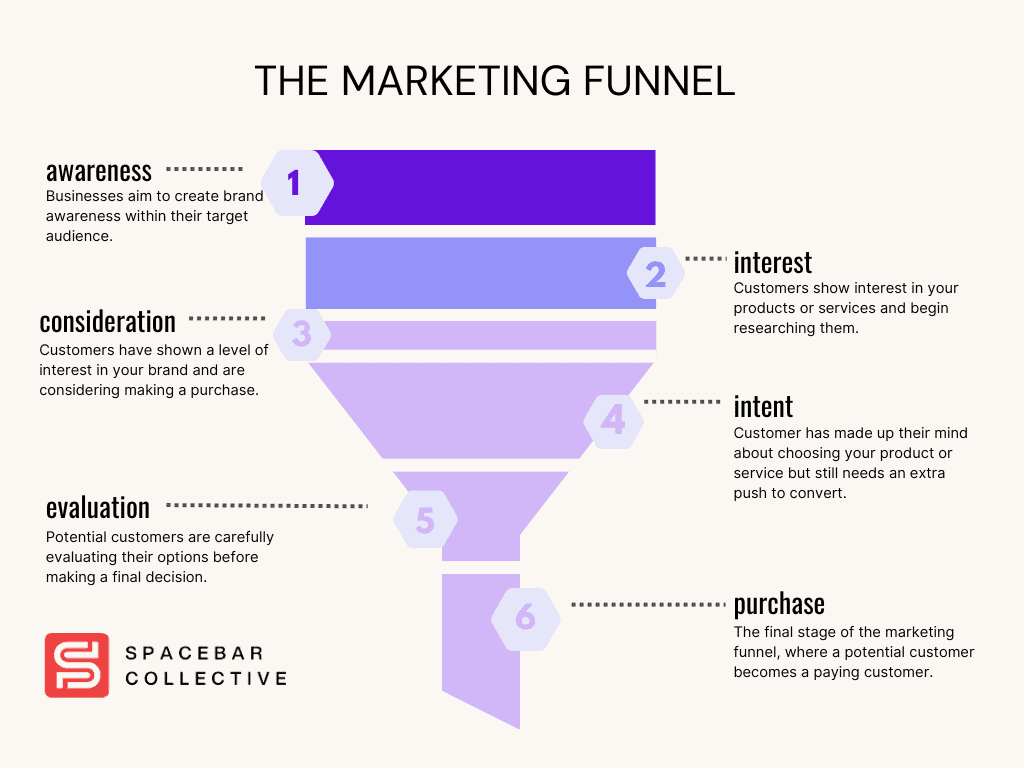
Categorising these 6 stages into top, middle and bottom of the funnel allows marketers to tailor their strategies according to each stage.
At the top of the funnel, you have the Awareness and Interest stages. This is when potential customers become aware of your brand and don’t know much about your offering yet.
In the middle of the funnel are the Consideration and Interest stages, where potential customers are starting to show interest in your brand and begin comparing it with competitors.
Finally, at the bottom of the funnel are the Evaluation and Purchase stages, where potential customers have gathered enough information they need to make a final purchase decision.
How to Prioritise Content Creation for B2B SaaS
While it may seem logical to prioritise top of funnel content so that your brand reaches the widest audience, you can actually drive signups quicker by focusing on bottom of funnel content first. This is because potential customers in the bottom of funnel stages are more likely to convert into paying customers with the right information.
When leveraging social media and SEO for B2B SaaS signups, bottom of funnel content helps attract qualified leads. These are potential users who have already done some research and are actively looking for a solution that meets their specific needs.
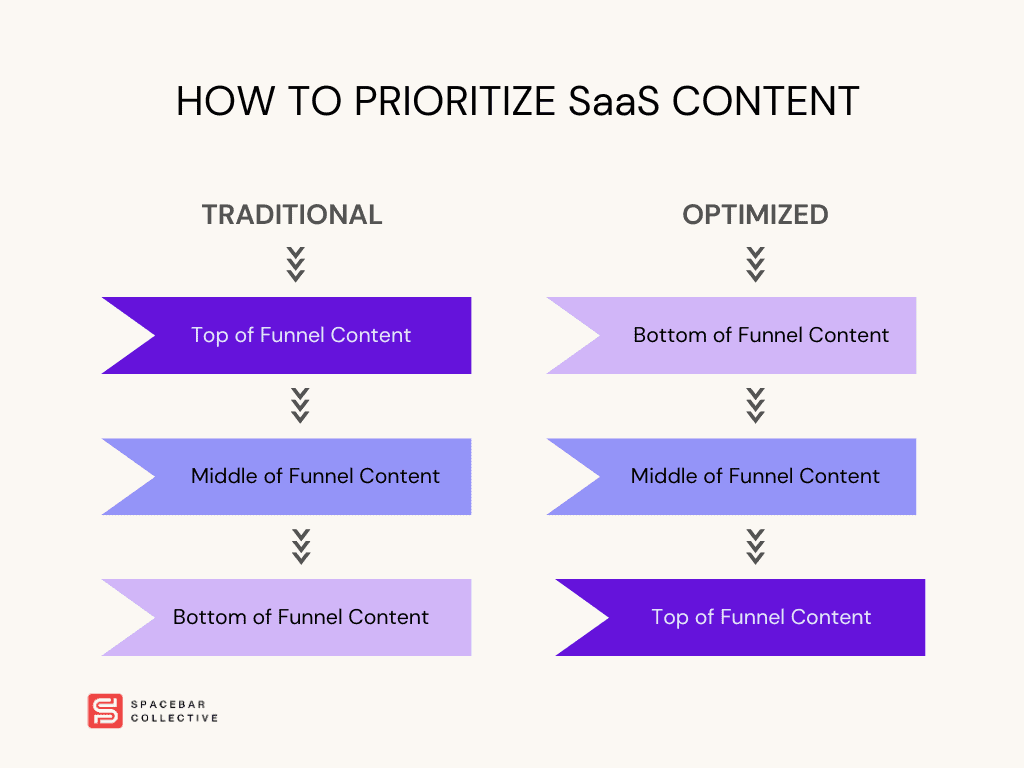
Content Formats for Each Stage of the Funnel
B2B SaaS companies in particular should use different content formats for different stages of the marketing funnel because it allows them to more effectively target and engage potential users at each stage of their buying journey.
Bottom of Funnel Content Types
We put the bottom of the funnel first because that’s where B2B SaaS companies should put their initial focus: bringing in conversions from those who are ready to make purchase decisions. At this stage, targeted content allows potential users to experience the product first-hand, imagine what it’s like implementing it into their business and make a well-informed decision before committing to a signup. Persuasive writing techniques should be your best friend when producing bottom of funnel content.
Product Pages: Product pages are excellent real estate for conversions since they’re your primary landing pages. They play a crucial role in the bottom of funnel content for SaaS companies because they are designed specifically to convert visitors into (paying) users. For many, this will be the first point of contact for potential users that have already gone through the awareness and consideration stages of the marketing funnel.
Providing detailed information about your software makes product pages one of the highest converting pieces of content you can develop. You’ll want to include things like features, benefits, pricing, customer reviews and access to case studies on your product pages. Basically, you’ll want to add any kind of information that helps potential users make an informed decision about whether or not your solution meets their needs.
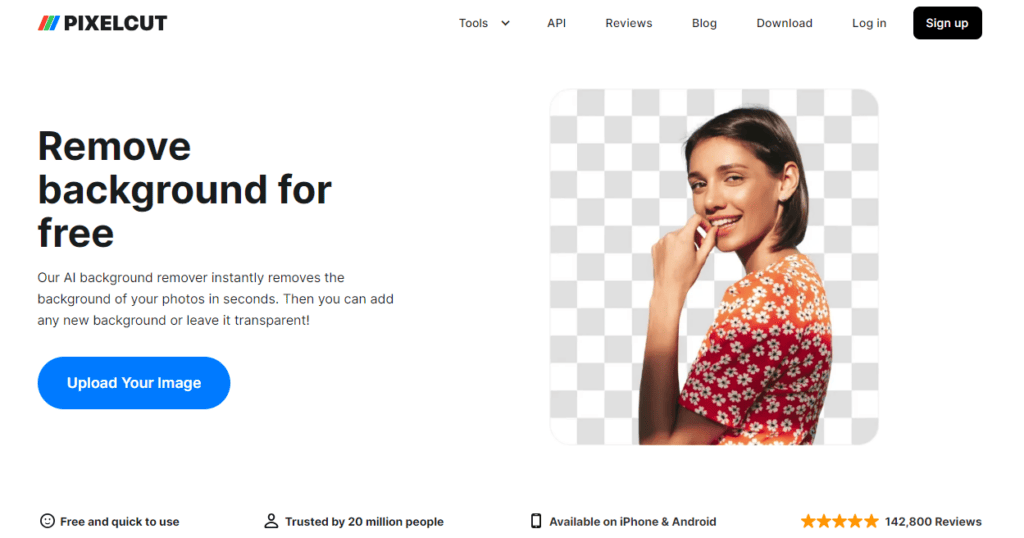
Example: PixelCut.ai – Background Remover
Pricing Pages: If you were to organise your bottom of funnel content into its own funnel, pricing pages would be at the very bottom. Pricing pages often serve as the final step in the purchasing decision-making process. This is because pricing pages address one of the most important concerns for consumers: cost. At this point in the marketing funnel, potential users seek out specific details about pricing plans, features and benefits before signing up.
Pricing pages are a great place for SaaS companies to showcase their value proposition by highlighting unique features and benefits of their software. By clearly outlining what sets them apart from competitors, pricing pages are one of the most effective ways to communicate the value of your software. They also help build trust with potential customers by providing transparency. In the case of enterprise SaaS, pricing can be muddled and locked behind sales calls. Offering your pricing upfront on a pricing page will help establish your SaaS as trustworthy.
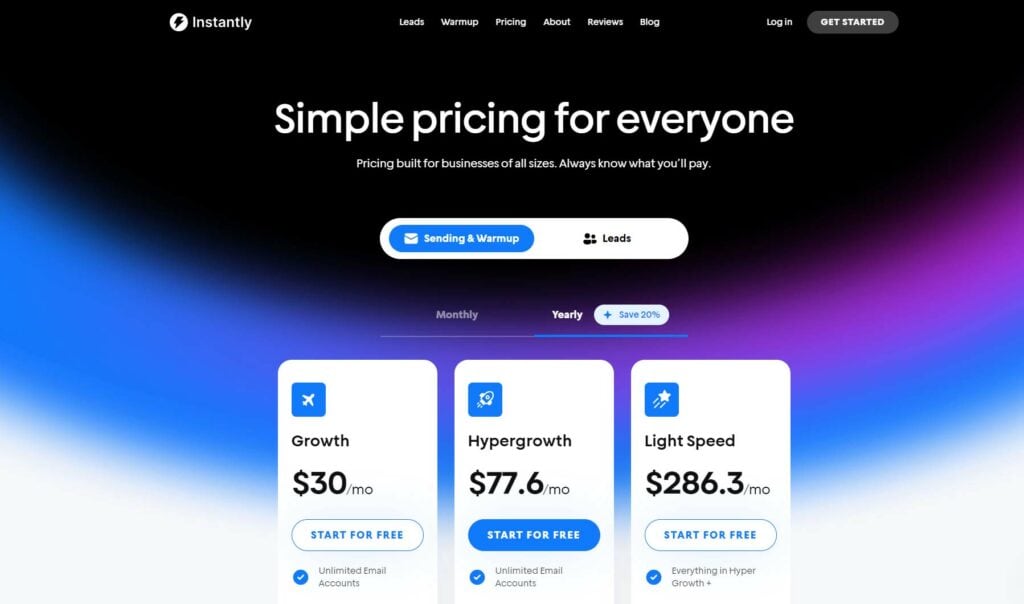
Example: Instantly.ai – Pricing Page
Use Case Pages: Use case pages are an effective type of bottom of funnel content because they provide potential users with a clear understanding of how your SaaS can solve their problems or meet their needs. This type of content is especially useful for converting potential users into signups because it demonstrates how your solution works and how it benefits them specifically. Use case pages demonstrate your ability to solve real-world problems in a level of detail that builds trust, making them more likely to convert to paying users.
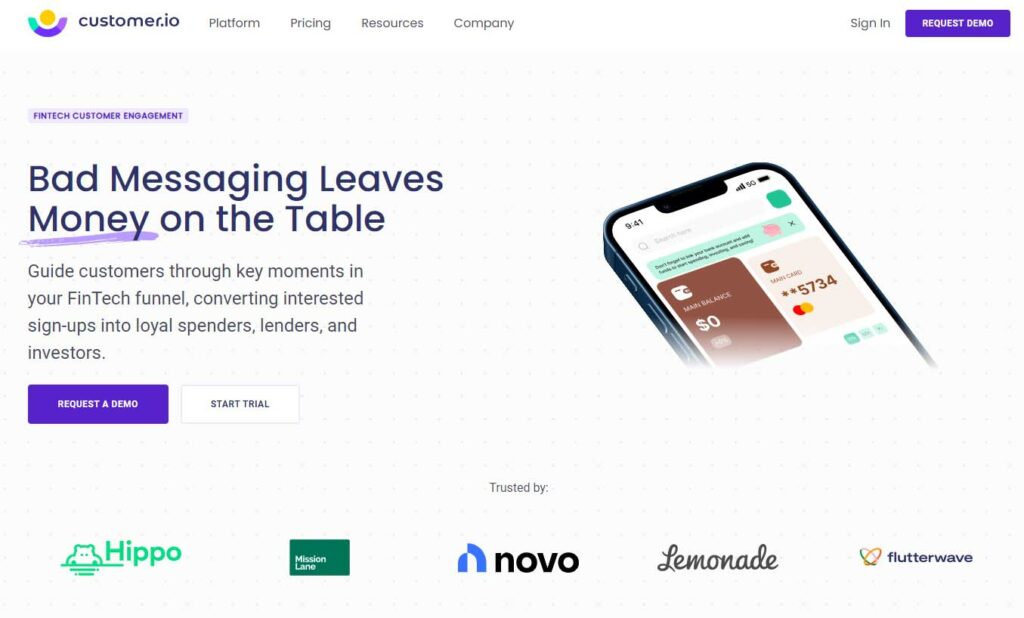
Example: customer.io FinTech Use Case page
“Alternative to” Pages: Comparing your SaaS directly to established players in your industry is an underrated way to target users actively searching for greener grass. These users are typically closer to making a purchasing decision than others and have already gone through the awareness and consideration stages of the buyer’s journey. Writing an unbiased comparison of the market as a one-stop comparison resource for users in the decision-making stage allows them to easily evaluate their options and choose the one best suited for their needs. Hopefully yours is best in category, as this type of content will only work if your SaaS is actually better than others. If that’s the case, expect a high conversion rate from your “alternative to” pages!
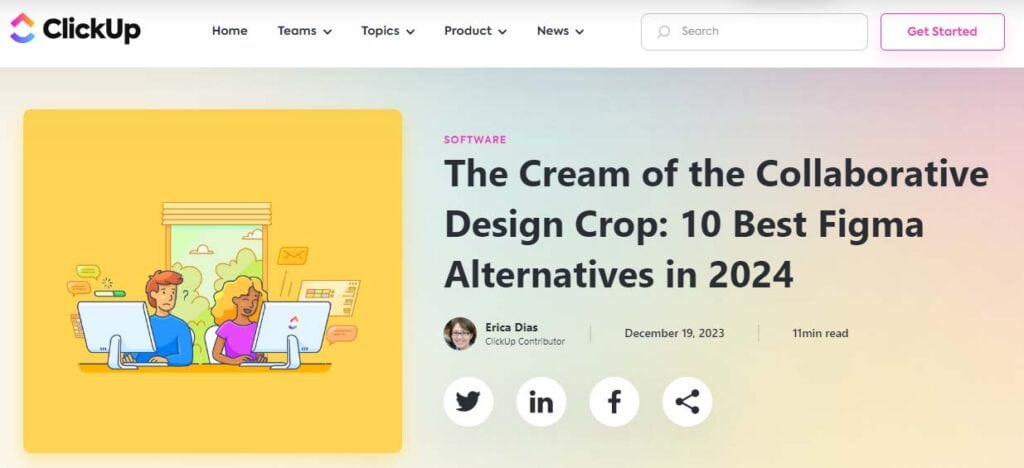
Example: ClickUp’s Figma alternatives blog
Buying Process Pages: When a company is actively seeking out the best software solution within a specific category, they’re already at the bottom of the marketing funnel and are ready to make a purchase decision. These types of pages allow SaaS companies to showcase their unique features, benefits and advantages over their competitors. What makes these pages especially powerful is that you can include social proof when explaining your SaaS to further convince potential users to choose your software.

Example: Publer’s LinkedIn automation software blog
Middle of Funnel Content Types
As potential users move down the funnel and are aware of your SaaS, more in-depth content to provide meaningful insights can be used. It’s at this stage that your content should focus on demonstrating how your software solves their pain points, pushing them closer towards making a purchase decision.
Product Tour Pages: Product tours provide potential users with a much deeper understanding of features and benefits of your software. These pages will typically include video explainer videos or interactive demonstrations that allow companies to see the product in action and get a feel for how it works. Product tours are almost essential for complex products because they can be difficult for customers to fully understand through text-based content alone. Tours are also a great place to showcase customer testimonials, case studies or use cases, which can help immensely with building trust.
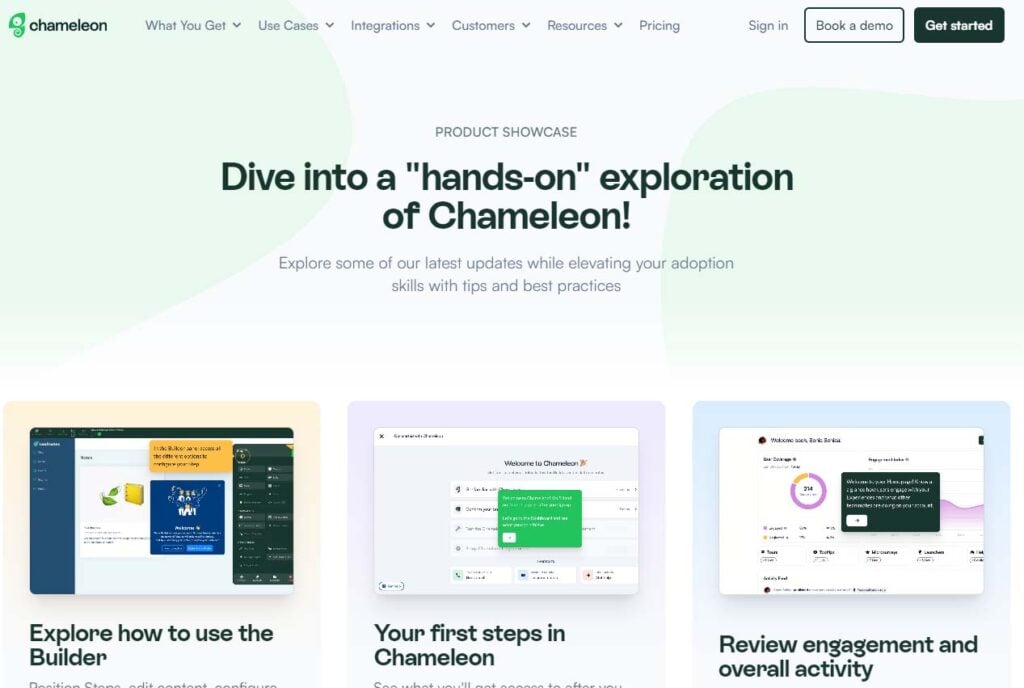
Example: Chameleon’s interactive product tour page
Product Tutorial Pages: Tutorials and any form of technical documentation serve as a bridge between the initial awareness stage and the final decision-making stage of the buyer’s journey. This type of content helps educate potential customers about specific features, implementation and functionality of the software, giving them a better understanding of how exactly it can solve their problems.
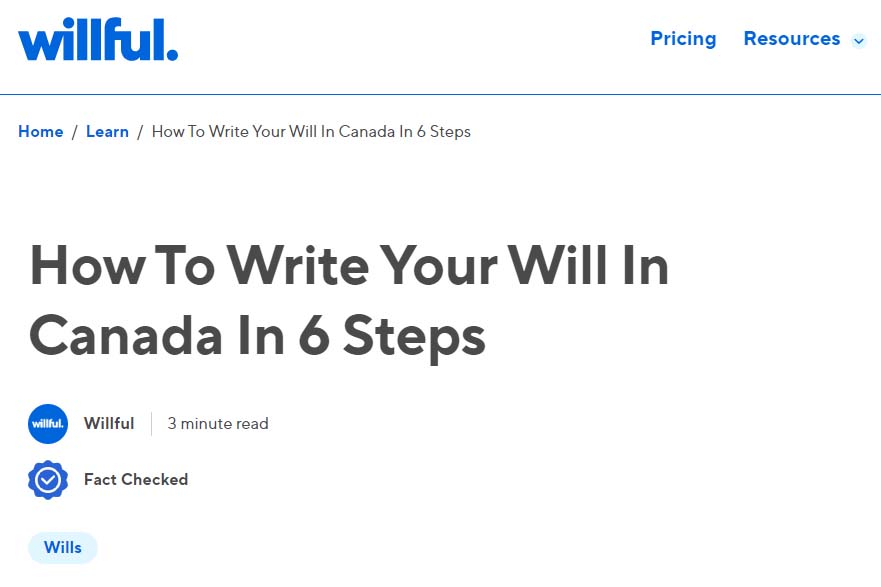
Example: Willful’s how to write your will in Canada blog
Case Study Pages: Case studies provide tangible evidence of the value and effectiveness of your software. This type of content showcases real-world examples and success stories from existing users, giving potential users a full picture of how your SaaS will benefit their business. Case study pages are where you can include specific details and metrics that show how you impact them. This includes things like cost savings, time savings and ROI.
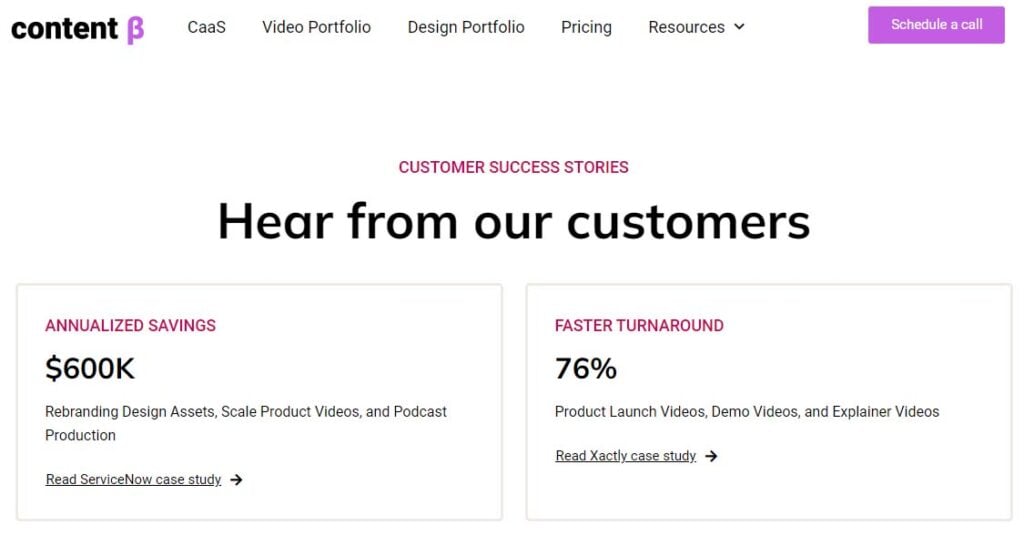
Example: Content Beta’s case study page
Interactive Tools: Offering free tools on your website allows potential users to actively engage in your software, providing a better understanding of the bigger picture: how your software works and its potential impact on their bottom line. Interactive tools give hands-on experience and allows companies to see the value of your software in action. Calculator tools that showcase the time or cost savings associated with your SaaS are a great starting point for those looking to get their feet wet.
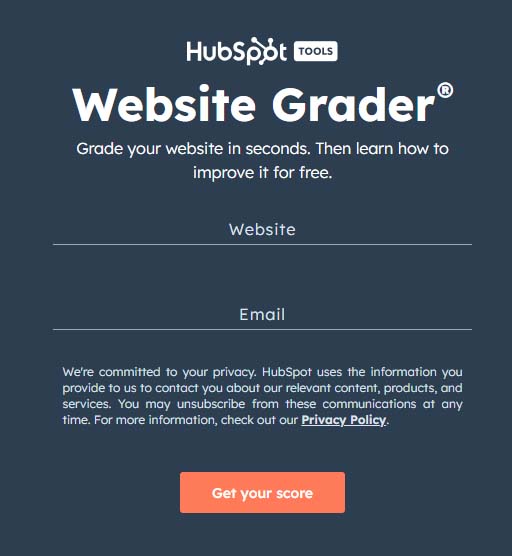
Example: HubSpot’s free website grader tool
Top of Funnel Content Types
At the top of the funnel, where customers are still becoming aware of your SaaS, visual and easily digestible content will help grab their attention and generate interest. This type of content is typically tailored towards garnering social shares to increase brand awareness and reach a large audience.
Ultimate Guides: Writing the most comprehensive as possible guide to a specific topic serves as a go-to resource for those just beginning to research a particular topic. Ultimate guides attract a broad range of people and a small percentage of them will be within your ICP. General guides like this are an opportunity to showcase expertise so that your ICP will keep you in mind when they’re closer to making a purchasing decision. You can also use this type of content as a place to educate potential users about your software and its benefits, so long as you aren’t being too salesy. Being subtle about product features as solutions to potential pain points will help build your credibility and keep you top of mind.
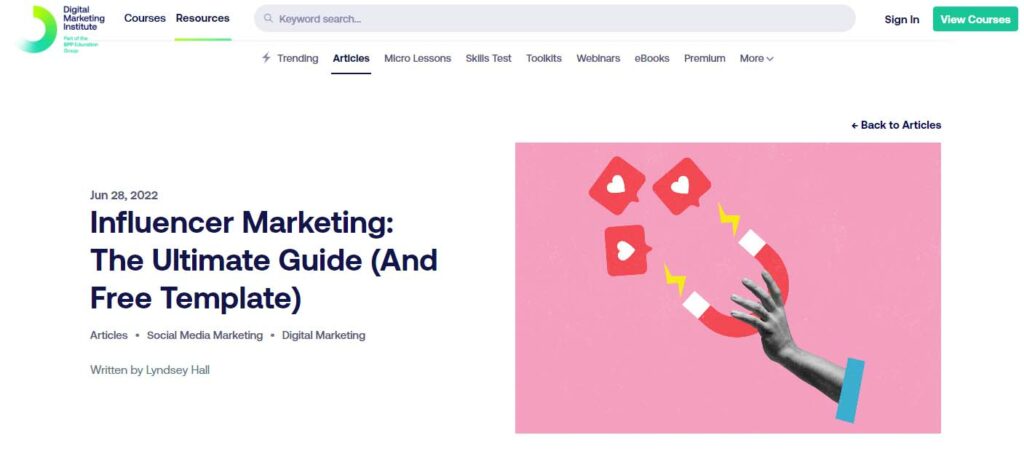
Example: Digital Marketing Institute’s ultimate influencer marketing guide
How-To Guides: These guides provide valuable information to potential users about how to solve a problem or achieve a specific goal using your software. This level of brand positioning can be powerful when executed correctly. When someone has a problem, they seek out solutions through search engines. Writing content geared towards helping solve problems will allow you to reach new audiences and introduce them to your SaaS.
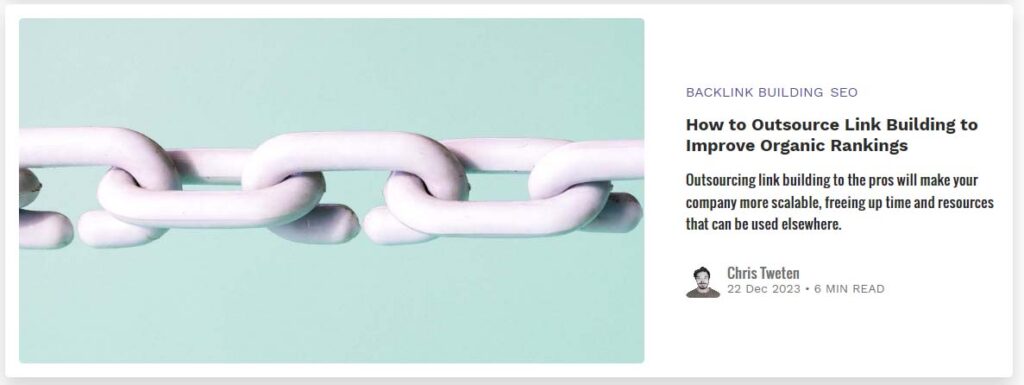
Example: Spacebar Collective’s how to outsource link building guide
Listicles: List format blog content is great for top of funnel customers because they’re easy to consume and skim. Providing bite-sized information that’s easily digestible with a scroll captures the attention of busy professionals who might not have the time to read long-form content. This also makes them more shareable than other forms of content, bringing in a wider net of potential users.
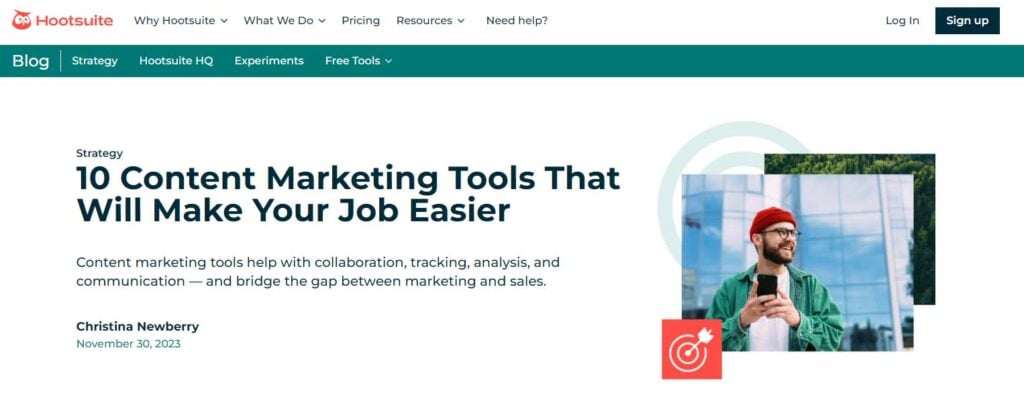
Example: HootSuite’s content marketing tools listicle
Thought Leadership: B2B SaaS companies often operate in complex and rapidly-changing fields, so customers are constantly looking for guidance and expertise to make more informed purchase decisions. Thought leadership pieces can showcase your understanding of the industry, trends and challenges faced by other companies. This helps position your brand as leaders in the space. On top of this, thought leadership pieces are highly shareable and can attract a wider readership beyond just potential users. The network effect can compound, putting your SaaS in the eyes of your ICP.
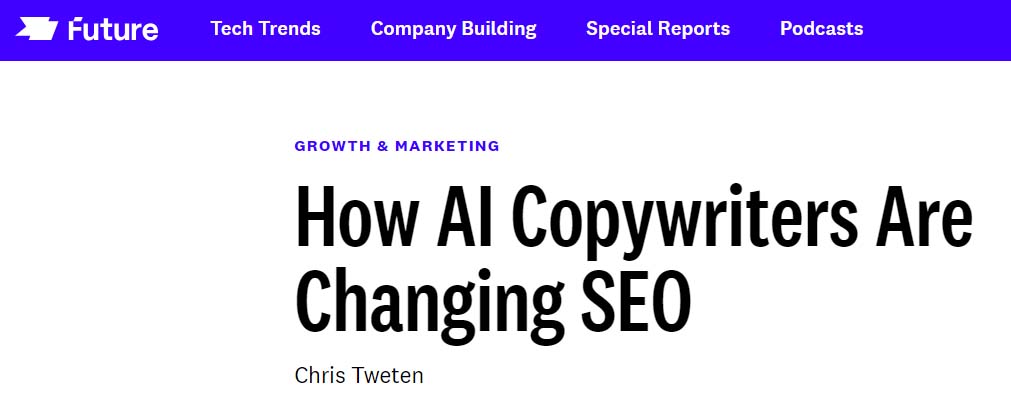
Example: Future’s How AI Copywriters Are Changing SEO piece
5 Growth Channels to Earn New Signups
Instead of relying on a single growth channel, B2B SaaS companies should diversify their growth efforts so their reach and potential isn’t limited. By using multiple channels, companies can tap into their ICP and increase brand awareness among a wider audience.
Using a variety of growth channels can also help diversify the types of users they bring in. For example, enterprise-level companies are more likely to convert off of SEO than they are from organic social media. Just because one channel works for a certain ICP does not mean it will work for all segments. Additionally, B2B SaaS companies can gain valuable data and insights into their market by tracking performance of individual channels to see which is most effective in acquiring new signups and to see which channels have the best retention as well. This data-driven approach allows you to optimise your content marketing efforts and improve your overall ROI.
SEO (Organic Search)
Unlike paid growth channels or even social media, SaaS SEO brings you new signups through owned channels: your website and its digital assets. By producing content for every stage of the customer acquisition funnel, your SaaS will be in a good position to earn organic signups.
B2B SaaS companies are uniquely positioned to leverage SEO as a growth channel because of the possibilities of websites they can earn backlinks from. Not only are the doors wide open for blogs in their specific software niche, but B2B SaaS companies can also get backlinks from software directories, entrepreneurship blogs and technology websites.
Although it can sometimes be more expensive to build links for SaaS companies because website admins will charge more than other industries (food and travel for example), there’s a wider net cast where you can hit higher volumes of quality links easier.
The other piece of the SEO puzzle you should take into consideration is blog content production. Google finds it hard to consider a website with less than 30 pages an authority on a topic, so it’s important that you build up a base library of content related to your industry. Showcasing your expertise in blog content will build a topical map for your website, signalling to Google that you know what you’re talking about and others should trust you.
Paid Social
Paid ads on social media are a great way to gain immediate traction, earning new signups by targeting a specific audience, generating leads and increasing brand awareness.
Running ads on LinkedIn allows businesses to target their ads towards demographics, interests and job titles. This targeting ability is especially powerful for B2B SaaS companies because you can reach decision-makers who are more likely to be interested in your software.
If you have an existing email list or large enough user base, you might want to consider lookalike audience advertising on Facebook and Instagram.
Paid Search
Paid ads on search engines like Google ensure your brand is displayed to relevant audiences who are actively searching for solutions for their business. By bidding on bottom of funnel keywords, your ads are placed above all organic search results, bringing in qualified traffic to your landing page.
Another basic, yet effective strategy is to bid on your competitors’ branded keywords. For example, Monday.com places their ads for the keyword “Trello.”
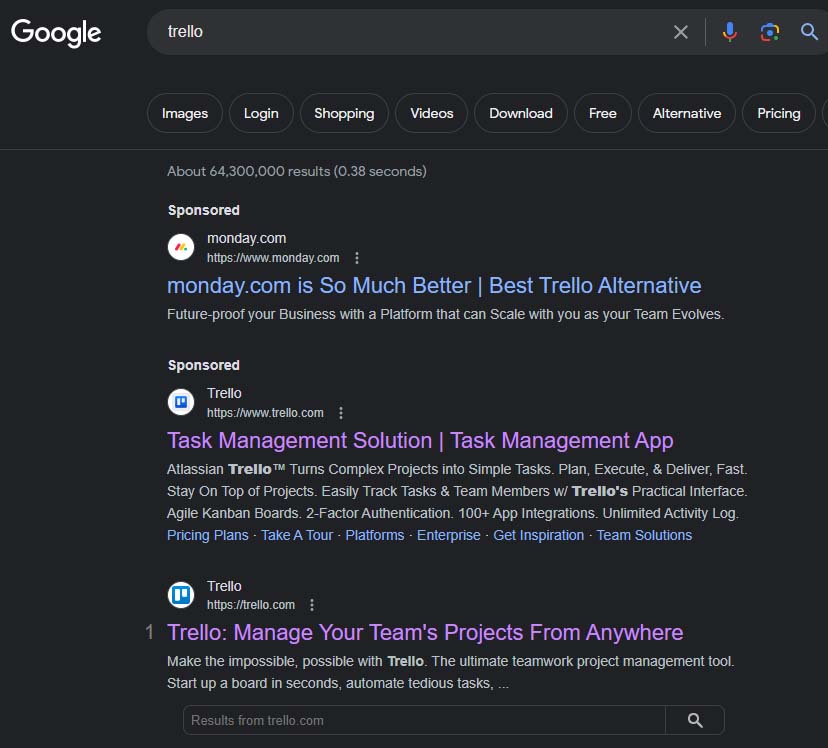
Organic Social
Although it takes some finesse, a bit of luck and plenty of patience, organic social media marketing is a good growth channel for your B2B SaaS because it’s cost-effective and helps build word of mouth. Unlike paid advertising channels, organic social media allows companies to reach your ICP through tailored messaging and content that directly appeals to potential signups.
If you’re looking to build your own community, social media is the place to do so. Performing well on social has a snowball effect on generating new signups. When your users engage with your posts and share them, it increases visibility beyond your own network and brings an influx of new signups from social referrals.
Referral Marketing
Referral marketing is one of the most cost-effective ways to earn new signups in the B2B SaaS game. Referral leads are relatively cheap compared to other growth channels, yet convert at a higher rate than any other type of lead. The problem with referral marketing is that it can be difficult to begin and can be quite inconsistent in terms of generating new leads. That’s why it works best as a supplementary SaaS content marketing channel, rather than a primary channel you rely on for signups.
If you’re looking to take full advantage of referrals as a growth channel, your best bet is to use referral software to automate your campaigns.
Final Thoughts
B2B SaaS content marketing is crucial for companies who want to take control of their own growth. By implementing content for each stage of the marketing funnel, SaaS companies are able to attract qualified leads that convert to signups. In doing so, they also learn to address pain points of their ICP and are able to position themselves as the solution to their problems.
For those who are ready to grow their SaaS business, SEO is a great starting point because it’s cost-effective, can tackle the bottom of the funnel immediately and has various long-term benefits. Unlike paid advertising campaigns, which require ongoing funding, SEO is a channel that can be invested into over an initial 6 month campaign and then reassessed.
If you’re geared for growth and are ready to tackle SEO as a growth channel, contact us at Spacebar Collective today and we can put together a custom quote for your SaaS.

